Click on images to enlarge

infestation (Photo: Rob and Fiona Richardson)
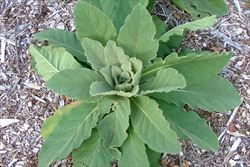
habit prior to flowering (Photo: Sheldon Navie)
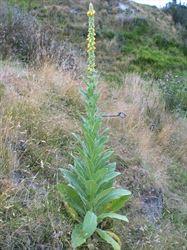
habit in flower (Photo: Trevor James)
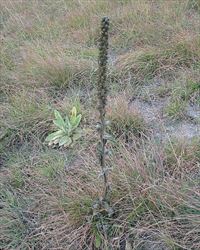
habit of old plant (Photo: Jackie Miles)
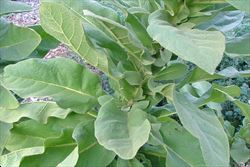
lower leaves (Photo: Sheldon Navie)
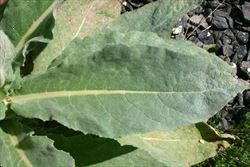
close-up of leaf (Photo: Trevor James)
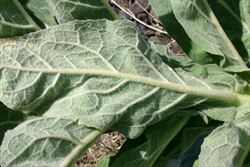
close-up of leaf underside (Photo: Trevor James)
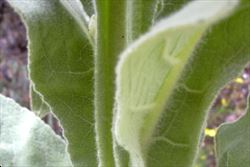
close-up of winged stem (Photo: Forest and Kim Starr, USGS)

upper leaves (Photo: Sheldon Navie)
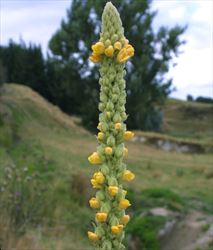
elongated flower cluster (Photo: Trevor James)
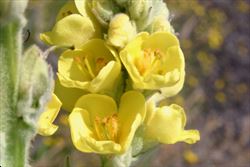
close-up of yellow flowers (Photo: Trevor James)
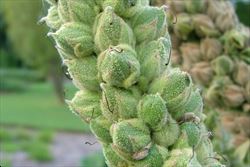
close-up of immature fruit (Photo: Sheldon Navie)
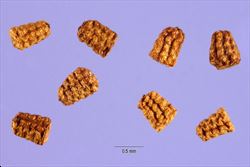
close-up of seeds (Photo: Steve Hurst at USDA PLANTS Database)

young plants (Photo: Sheldon Navie)
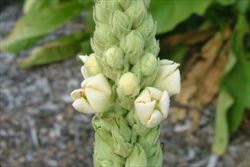
the white-flowered form of this species, which is often known as Verbascum thapsus forma candicans (Photo: Sheldon Navie)
Scientific Name
Verbascum thapsus L.
Synonyms
Verbascum blattaria L. (misapplied)Verbascum schraderi MeyerVerbascum thapsus L. subsp thapsus
Family
Scrophulariaceae
Common Names
Aaron's rod, big taper, blanket weed, blanket-leaf, candle-wick, candlewick, common mullein, devil's-tobacco, flannel leaf, flannel leaved mullein, flannel plant, flannel-leaf, flannelleaf, flannelplant, great mullein, hag taper, hedge taper, iceleaf, Jacob's staff, Jacob's-staff, mullein, shepherd's club, torches, velvet dock, velvet plant, velvet-leaf, velvetplant, wild tobacco, woolly mullein
Origin
Native to the Azores, the Madeira Islands, Canary Islands, Europe, the middle-east, western and northern Asia, and the Indian Sub-continent.
Naturalised Distribution
Widely naturalised in southern and eastern Australia (i.e. in south-eastern Queensland, New South Wales, the ACT, Victoria, Tasmania, south-eastern South Australia and the coastal districts of south-western Western Australia). Also naturalised on Norfolk Island.
Widely naturalised overseas, including in tropical Asia, La Réunion, New Zealand, North America (i.e. Alaska, the USA and Canada), Hawaii and southern South America.
Habitat
A weed of pastures, roadsides, railways, disturbed sites, waste areas, stony river-beds and cultivation in temperate, sub-tropical and sometimes also semi-arid regions.
Habit
A large, but short-lived (i.e. annual or biennial), herbaceous plant growing up to 3 m in height, but usually 1-2 m tall. It is a very upright (i.e. erect) plant, but initially grows as a basal rosette of leaves (up to 60 cm across).
Distinguishing Features
- a large, short-lived herbaceous plant growing up to 3 m tall.
- a basal rosette of very large leaves is initially produced, followed by a single upright main stem.
- its stems and leaves are densely hairy and either greyish-green or silvery in appearance.
- the alternately arranged stem leaves reduce in size and become narrower towards the top of the plant.
- these leaves are stalkless and their bases form 'wings' along the stem.
- its yellow flowers (12-30 mm across) are densely arranged in a large elongated cluster (20-100 cm long) at the top of the stems.
- its small fruit capsules (7-10 mm long and 3-6 mm wide) are covered in tiny hairs.
Stems and Leaves
This plant usually only has a single, upright (i.e. erect), thick, main stem (although it may rarely produce a few branches in the upper leaf forks). These stems are densely hairy (i.e. pubescent) and they are somewhat 'winged' in nature.
The leaves are greyish-green or silvery in colour and woolly in nature, due to the presence of a dense covering of short, star-shaped (i.e. stellate) hairs. Rosette leaves are egg-shaped in outline (i.e. ovate) or oval (i.e. elliptic) in shape, shortly-stalked (i.e. petiolate) or stalkless (i.e. sessile), and usually very large (8-50 cm long and 2.5-14 cm wide). Stem (i.e. cauline) leaves are alternately arranged and reduce in size towards the top of the plant (up to 40 cm long and 10 cm wide). These leaves are also egg-shaped in outline (i.e. ovate) or oval (i.e. elliptic) in shape, but tend to be somewhat narrower than the rosette leaves. They are stalkless (i.e. sessile) and the 'wings' that are formed down the stem arise from their bases (i.e. they are decurrent). All leaves have prominent veins on their undersides and have entire or slightly toothed (i.e. crenate or crenulate) margins.
Flowers and Fruit
The flowers (12-30 mm across) are densely arranged in a large elongated cluster at the top of the stems (i.e. in a terminal spike-like raceme). These flower clusters are very hairy (i.e. woolly) and are 20-100 cm long. The numerous yellow flowers are arranged in groups of 1-7 above small, leafy, bracts and each is borne on a very short stalk (i.e. pedicel) that is only 1-5 mm long. These flowers have five petals, that are fused at the base, five greyish hairy sepals (6-12 mm long) and five stamens (10-15 mm long). they also have an ovary topped with a style and stigma. Flowering occurs mostly during spring, summer and early autumn.
The fruit is a rounded (i.e. globular) or egg-shaped (i.e. ovoid) capsule (7-10 mm long and 3-6 mm wide) that is covered in tiny hairs. These fruit turn from green to brown as they mature and contain numerous tiny seeds. The seeds (about 1 mm long and 0.5 mm wide) are reddish-brown, brown or dark grey in colour, rod-shaped (i.e. cylindrical), and roughly textured (i.e. pitted and ridged).
Reproduction and Dispersal
Reproduction is entirely by seeds, and these are easily spread due to their very small size.
Potential dispersal agents include wind, water, animals, and vehicles. Seeds may also be spread in mud and as a contaminant of agricultural produce.
Environmental Impact
Great mullein (Verbascum thapsus) is regarded and an environmental weed in Victoria, and as a minor or potential environmental weed in New South Wales, the ACT and Queensland.
Legislation
This species is declared under legislation in the following states and territories:
- Victoria: P1 - prohibited and must be eradicated or controlled (in the West Gippsland region only), and C5 - all reasonable steps must be taken to control the weed and prevent its spread (in the Corangamite, Port Phillip West, Goulburn, North East and East Gippsland regions).
- Western Australia: Unassessed - this species is declared in other states or territories and is prohibited until assessed via a weed risk assessment (throughout the entire state).
Management
For information on the management of this species see the following resources:
- the Victorian Department of Primary Industries Landcare Note on this species, which is available online at http://www.dpi.vic.gov.au.
Similar Species
Great mullein (Verbascum thapsus) is similar to twiggy mullein (Verbascum virgatum), moth mullein (Verbascum blattaria) and cretan mullein (Verbascum creticum). These species can be distinguished by the following differences:
- great mullein (Verbascum thapsus) has greyish-green stems and leaves that are densely covered in tiny star-shaped (i.e. stellate) hairs. The flowering stems of this species are robust and rarely branched (and only small branches are formed in the upper leaf forks). Flowers are densely arranged along the flowering stems on short stalks (i.e. pedicels) 1-5 mm long. The immature fruit are densely covered in tiny hairs (i.e. they are tomentose).
- twiggy mullein (Verbascum virgatum) has dark green stems and leaves that are sparsely covered in simple or sticky (i.e. glandular) hairs. The flowering stems of this species are not as robust and are more commonly branched (several large branches are often formed just above the rosette). Flowers are loosely arranged along the flowering stems, when they are mature, on very short stalks (i.e. pedicels) 1-2 mm long. The immature fruit are sparsely covered in sticky (i.e. glandular) hairs.
- moth mullein (Verbascum blattaria) has dark green stems and leaves that are hairless (i.e. glabrous) or sparsely hairy. Its rosette leaves are deeply toothed or lobed and its flowers are loosely arranged along the flowering stems on relatively long stalks (i.e. pedicels) 10-25 mm long.
- cretan mullein (Verbascum creticum) has dark green stems and leaves that are moderately hairy and its leaves have a somewhat wrinkled (i.e. rugose) appearance. It can be distinguished from all of the other species by having four stamens (instead of five) and by its toothed (i.e. serrated) sepals (all the other species have entire sepals).

